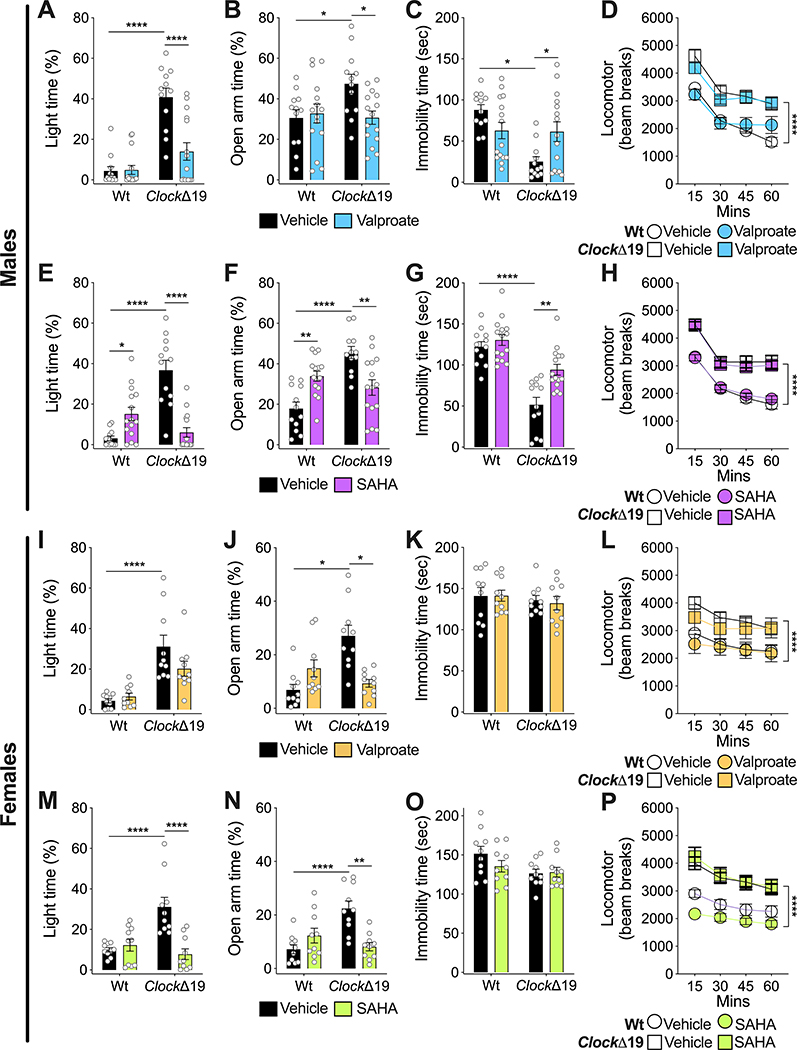Figure 1.
VPA and HDAC inhibition via SAHA reverse manic-like behaviors in ClockΔ19 mice. Male (A-D) and female (I-L) Wt and ClockΔ19 mice were treated with VPA and tested for exploratory drive and avoidance behavior in the dark/light box (A, I) and EPM (B, J), behavioral despair in the FST (C, K), and locomotor response to novelty (D, L). Vehicle-treated male ClockΔ19 mice (n=12) displayed increased time spent in the light side of the dark/light box (A), increased time in the open arm of the EPM (B), decreased immobility in the FST (C), and increased locomotor response to novelty (D) compared to Wt mice (n=12). Treatment of male ClockΔ19 mice (n=15) with VPA normalized time spent in the light side of the dark/light box (A), open arm time in the EPM (B), and immobility in the FST (C). However, VPA treatment had no effect on locomotor response to novelty (D). VPA treatment had no effect on male Wt mice (n=15) (A-D). Vehicle-treated female ClockΔ19 mice (n=10) also showed increased time spent in the light side of the dark/light box (I), increased time in the open arm of the EPM (J), and increased locomotor response to novelty (L), compared to Wt mice (n=10). However, there was no genotype effect for immobility time in the FST (K). Treatment of female ClockΔ19 mice with VPA partially normalized time spent in the light side of the dark/light box (I) and normalized open arm time in the EPM (J), but had no effect on immobility time in the FST (K) and locomotor response to novelty (L). VPA treatment also had no effect on female Wt mice (I-L). Male (E-H) and female (M-P) Wt and ClockΔ19 mice were treated with SAHA and underwent the same behavioral testing as the VPA experiment, including dark/light box (E, M), EPM (F, N), FST (G, O), and locomotor response to novelty (H, P). Similar to the VPA experiment (A-D), vehicle-treated male ClockΔ19 mice showed increased time spent in the light side of the dark/light box (E), increased time in the open arm of the EPM (F), decreased immobility time in the FST (G), and increased locomotor response to novelty (H), compared to Wt mice. Treatment of male ClockΔ19 mice with SAHA normalized time spent in the light side of the dark/light box (E), open arm time in the EPM (F), and immobility in the FST (G), with no effect on locomotor response to novelty (H). SAHA-treated Wt mice also showed an increase in time in the light side of the dark/light box (E) and an increase in time in the open arm of the EPM (F). Similar to the VPA experiment (I-L), vehicle-treated female ClockΔ19 mice also showed increased time spent in the light side of the dark/light box (M), increased time in the open arm of the EPM (N), and increased locomotor response to novelty (P), with no effect on immobility time in the FST (O). Treatment of female ClockΔ19 mice with SAHA normalized time spent in the light side of the dark/light box (M) and open arm time in the EPM (N), with no effect on immobility time in the FST (O) or locomotor response to novelty (P). SAHA treatment had no effect on female Wt mice (M-P). Data is represented as mean ± SEM. Data in A-C, E-G, I-K, M-O were analyzed using two-way ANOVA followed by Tukey’s post hoc tests if significant interaction. Data in D, H, L, P were analyzed using two-way repeated measures ANOVA. *p <0.05, **p<0.01, ****p<0.0001, with lines between bars representing significant differences between those groups.

